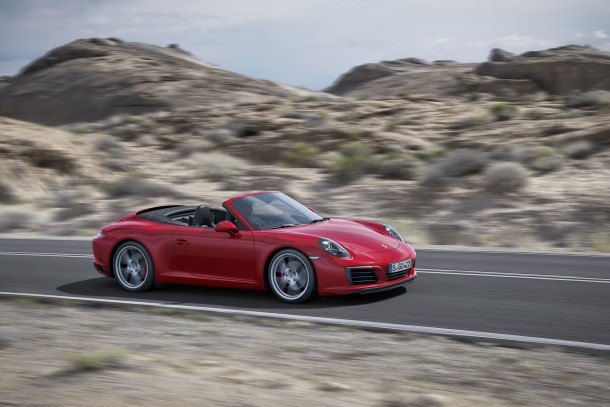It's All Turbos From Here: 2017 Porsche 911 Comes Boosted Out of The Box

Porsche announced on Sunday that when its new 2017 Porsche 911 Carrera and Carrera S go on sale in March 2016 they’ll be force-fed air through twin turbochargers — and not naturally aspirated like nature intended.
Instead of a 3.6-liter flat-six behind its rear wheels, the new 911 Carrera and Carrera S will sport a twin-turbocharged, 3-liter, flat-six engine. (Porsche didn’t directly specify in its statement the engine’s number of cylinders, so if you want to play a fun game today, read how some outlets have written around it.)
As our own Tim Cain points out, the output of the new turbocharged Carrera and Carrera S, which is 370 horsepower and 420 horsepower respectively, is shockingly close to the 415 horsepower produced by the 996 Turbo from 2000.
Unsurprisingly, Porsche boosted the price too — a new Carrera will run $89,400 before delivery and options, which is more than $5,000 dearer than the current generation.
According to Porsche, the Carrera and Carrera S will share virtually identical engines, but the S model will sport a slightly different turbo and exhaust system to achieve the 50 horsepower delta over the Carrera.
By switching to the turbocharged mill, Porsche says that its engines will produce more torque — up 44 pounds-feet in the Carrera and 43 pounds-feet in the Carrera S — and spin up to 7,500 rpm.
The Carrera S’s price will now swell to $103,400, and the cabriolet versions will start at $101,700 and $115,700 for the droptop Carrera and Carrera S cars respectively.
The Carrera S will also sport rear-axle steering as an option for the first time in 2016, adopted from the current Turbo and GT3. Porsche says its active suspension management will be standard for all Carreras and will lower the car by 10 millimeters to improve handling.
The redesigned car also sports slightly new headlights, and a redesigned rear tail with retro-looking rear vents.

More by Aaron Cole
Latest Car Reviews
Read moreLatest Product Reviews
Read moreRecent Comments
- Alan Years ago Jack Baruth held a "competition" for a piece from the B&B on the oddest pickup story (or something like that). I think 5 people were awarded the prizes.I never received mine, something about being in Australia. If TTAC is global how do you offer prizes to those overseas or are we omitted on the sly from competing?In the end I lost significant respect for Baruth.
- Alan My view is there are good vehicles from most manufacturers that are worth looking at second hand.I can tell you I don't recommend anything from the Chrysler/Jeep/Fiat/etc gene pool. Toyotas are overly expensive second hand for what they offer, but they seem to be reliable enough.I have a friend who swears by secondhand Subarus and so far he seems to not have had too many issue.As Lou stated many utes, pickups and real SUVs (4x4) seem quite good.
- 28-Cars-Later So is there some kind of undiagnosed disease where every rando thinks their POS is actually valuable?83K miles Ok.new valve cover gasket.Eh, it happens with age. spark plugsOkay, we probably had to be kewl and put in aftermarket iridium plugs, because EVO.new catalytic converterUh, yeah that's bad at 80Kish. Auto tranny failing. From the ad: the SST fails in one of the following ways:Clutch slip has turned into; multiple codes being thrown, shifting a gear or 2 in manual mode (2-3 or 2-4), and limp mode.Codes include: P2733 P2809 P183D P1871Ok that's really bad. So between this and the cat it suggests to me someone jacked up the car real good hooning it, because EVO, and since its not a Toyota it doesn't respond well to hard abuse over time.$20,000, what? Pesos? Zimbabwe Dollars?Try $2,000 USD pal. You're fracked dude, park it in da hood and leave the keys in it.BONUS: Comment in the ad: GLWS but I highly doubt you get any action on this car what so ever at that price with the SST on its way out. That trans can be $10k + to repair.
- 28-Cars-Later Actually Honda seems to have a brilliant mid to long term strategy which I can sum up in one word: tariffs.-BEV sales wane in the US, however they will sell in Europe (and sales will probably increase in Canada depending on how their government proceeds). -The EU Politburo and Canada concluded a trade treaty in 2017, and as of 2024 99% of all tariffs have been eliminated.-Trump in 2018 threatened a 25% tariff on European imported cars in the US and such rhetoric would likely come again should there be an actual election. -By building in Canada, product can still be sold in the US tariff free though USMCA/NAFTA II but it should allow Honda tariff free access to European markets.-However if the product were built in Marysville it could end up subject to tit-for-tat tariff depending on which junta is running the US in 2025. -Profitability on BEV has already been a variable to put it mildly, but to take on a 25% tariff to all of your product effectively shuts you out of that market.
- Lou_BC Actuality a very reasonable question.













































Comments
Join the conversation
So they've separated the tail lamps again, which is sad. 911 tip! The 911's worth the most money later always have joined tail lamps. Get a 2015 before they're gone!
Actually, this sounds like a good implementation of forced induction. By choosing a 3.0 engine displacement, two turbos and output no higher than 420 HP this should translate into low pressure boost, low turbo lag and good throttle response even off-boost. A gain in power, torque, efficiency and speed is progress - no matter what the so called "purists" and Internet forum dwellers think.